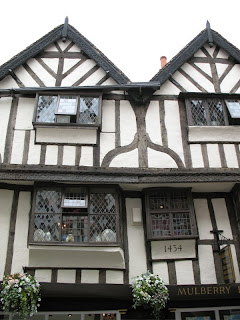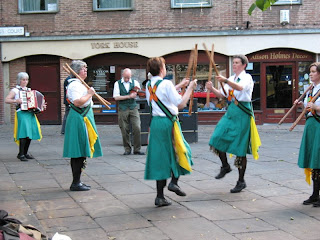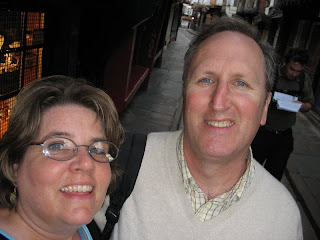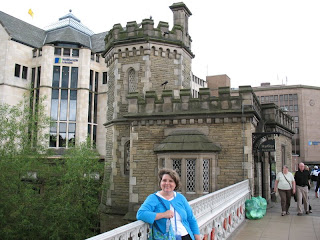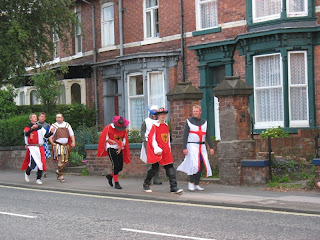He marched them up the hill,
And marched them down again.
And when you’re up, you’re up;
And when you’re down, you’re down.
And when you’re only halfway up,
You’re neither up nor down!
This old song kept running through my head as we went up and down the walls. It refers to the wars over York that apparently took years and years to settle out. I’m a little fuzzy on my history, but when you show up in York, you know they had some.
 Or this gate was built ages and ages before George Washington ever crossed the Delaware? Oh yes, said one British tourist to a fellow American traveler (they were teen-aged), American history only takes one day to cover in our schools.
Or this gate was built ages and ages before George Washington ever crossed the Delaware? Oh yes, said one British tourist to a fellow American traveler (they were teen-aged), American history only takes one day to cover in our schools.
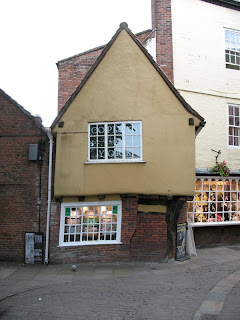 You can also tell the age of something (someone) by how much they’re sagging in the midsection. I like how the window has kept right up with the leaning.
You can also tell the age of something (someone) by how much they’re sagging in the midsection. I like how the window has kept right up with the leaning.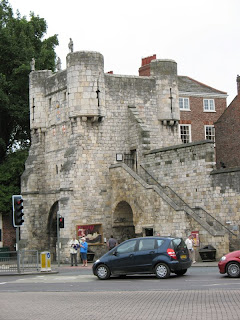 And when you’re up, you’re up. . . Yes, on our tour arranged by the local tourist office (free!) we went up these stairs to the wall surrounding York. This bar (or gate) is called Bootham Bar.
And when you’re up, you’re up. . . Yes, on our tour arranged by the local tourist office (free!) we went up these stairs to the wall surrounding York. This bar (or gate) is called Bootham Bar.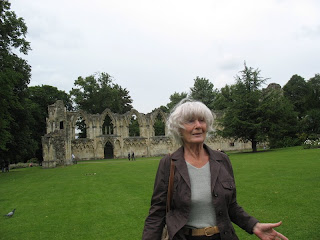 Our guide had great stories. I did want to see ruined castles, and was happy to note that York had a ruined building right in their main park: St. Mary’s Abbey. They’re big on ghosts around here, with ghost tours of all the gruesome things that have happened over the ages. I guess America’s ghosts, by comparison, would be toddlers.
Our guide had great stories. I did want to see ruined castles, and was happy to note that York had a ruined building right in their main park: St. Mary’s Abbey. They’re big on ghosts around here, with ghost tours of all the gruesome things that have happened over the ages. I guess America’s ghosts, by comparison, would be toddlers.
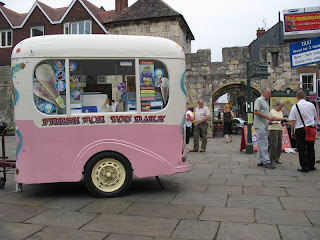 Some local sights: an ice cream trailer. It’s only here in the day.
Some local sights: an ice cream trailer. It’s only here in the day.
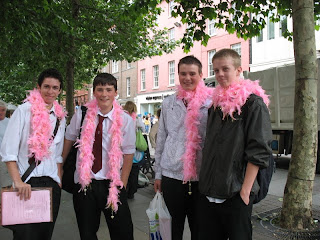 These school boys posed for me in their feather boas–I don’t know why they had them, but shortly after this, they all took them off.
These school boys posed for me in their feather boas–I don’t know why they had them, but shortly after this, they all took them off.
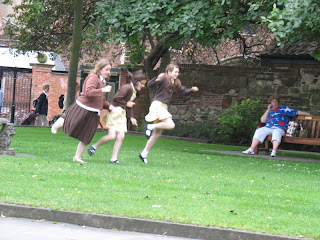 After school games on the green in the back of the York Minster.
After school games on the green in the back of the York Minster.
This group of women dresses all up in official bell-adorned knee socks, green skirts, sashes, kerchiefs, white blouses and black athletic shoes to dance in the little square across from Barnett’s Hardware store, by the sagging building shown above. This happens every Wednesday evening, and according to the flyer, you are invited to join. There used to be a church on this square, and the steps up to the high altar remain. They danced down in what used to be the nave.
The accordion player was nimble on the keyboards, and the violinist, spritely. Unfortunately for them, York is a weird tourist town: bustling by day, ghost town by evening. Later on, we found out why: the buses that carry the tourists to the car parks on the outside of the city stop running at 8 p.m. Yes, that would be OUR bus. Because of this, the audience for these energetic, middle-aged women was limited. We put some money in their hat.
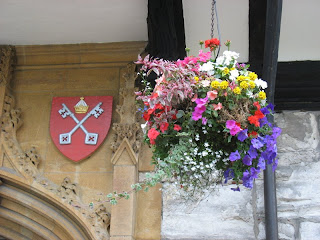 The insignia of the crossed keys were everywhere. The tour guide said later it was a key to the Gates of Heaven and the Gates of Hell. After Evensong that night, I asked the kindly man in York Minster (who was sporting a badge with the same design) if he thought that’s what they represented. He said the design represents the keys given to St. Peter. He had a sly smile on his face and mused aloud: “I can see why one might want the keys to heaven. But the other place? No, I think it means keys–plural–to heaven.”
The insignia of the crossed keys were everywhere. The tour guide said later it was a key to the Gates of Heaven and the Gates of Hell. After Evensong that night, I asked the kindly man in York Minster (who was sporting a badge with the same design) if he thought that’s what they represented. He said the design represents the keys given to St. Peter. He had a sly smile on his face and mused aloud: “I can see why one might want the keys to heaven. But the other place? No, I think it means keys–plural–to heaven.”
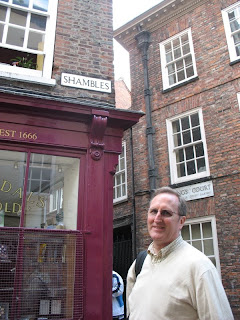 After dinner, Dave and I meandered to the main touristy street: Shambles. Apparently it used to be a street where the butchers plied their trades. It takes its name from the Saxon word shamel, meaning “slaughterhouse.” Only one butcher remains.
After dinner, Dave and I meandered to the main touristy street: Shambles. Apparently it used to be a street where the butchers plied their trades. It takes its name from the Saxon word shamel, meaning “slaughterhouse.” Only one butcher remains.
Mostly it’s (and to quote from our Lonely Planet travel guide): “. . . the quaintly cobbled Shambles, complete with overhanging Tudor buildings, hints at what a medieval street might have looked like if it was overrun with people told they have to buy something silly and superfluous and be back on the tour bus in 15 minutes.”
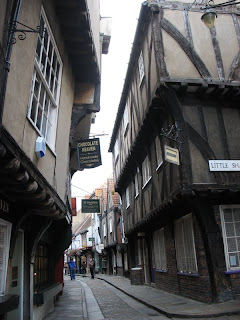 Obviously all the tourists have cleared out. The u
Obviously all the tourists have cleared out. The u
pper buildings do lean in toward each other.
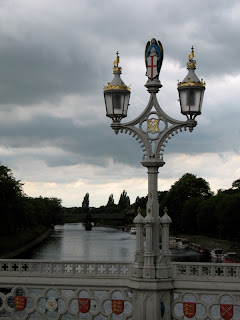 This is taken the next day. We were walking around after our museum visits and decided to go walk the other side of the wall. Storm clouds were gathering, but Dave paused to snap the photo of the River Ouse, which divides the town, plus this elegant light post.
This is taken the next day. We were walking around after our museum visits and decided to go walk the other side of the wall. Storm clouds were gathering, but Dave paused to snap the photo of the River Ouse, which divides the town, plus this elegant light post.
See next post for more York Minster.
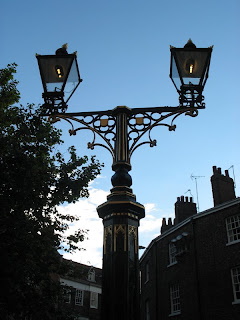 When the street lights started to flicker on, we knew it was time to go home to our B & B.
When the street lights started to flicker on, we knew it was time to go home to our B & B.
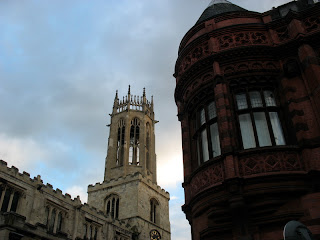 I don’t know what this tower was–maybe to a church? The dark one in front is now a bank.
I don’t know what this tower was–maybe to a church? The dark one in front is now a bank.
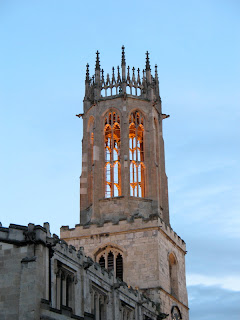 So we head to our bus stop and discover that we had purchased roundtrip tickets on a park-and-ride bus, which stops running at 8 p.m. It was now 8:40. So we decide to take a city bus and head to the other side of the street, where one was supposed to come at 9:08. The chef for the local cafe was hanging out there talking to a friend, and they offered to help us. We showed them where we needed to go. “Oh, that’s a 15 minute walk, easy.”
So we head to our bus stop and discover that we had purchased roundtrip tickets on a park-and-ride bus, which stops running at 8 p.m. It was now 8:40. So we decide to take a city bus and head to the other side of the street, where one was supposed to come at 9:08. The chef for the local cafe was hanging out there talking to a friend, and they offered to help us. We showed them where we needed to go. “Oh, that’s a 15 minute walk, easy.”
Because this was the first time I’d gotten an estimate from a Brit about how long a walk something was, I believed him, and set out on our tired tourist feet towards home.
After about a half-an hour, I sat down to rest at a bus stop. When is that bus coming to this stop? Shortly, it turned out. However, it was a city bus, but the kindly female bus driver with a deep gravelly male voice let us on, as lost as we were. Then she took a turn off the main street. The lady Dave was sitting by said “not to worry,” and the man I was sitting by said “It’ll be back on the main road. Don’t you worry.” So after a detour around the edges of Fulham and back, we were dropped off at our bus stop in front of our B&B close to 10 p.m. It was still dusk, however, so it didn’t feel that late.
Of course, if you’d asked our feet, they would have said something different. I learned to double whatever time someone would give for an estimate for distances or walking. And to check the time of the last running bus.
